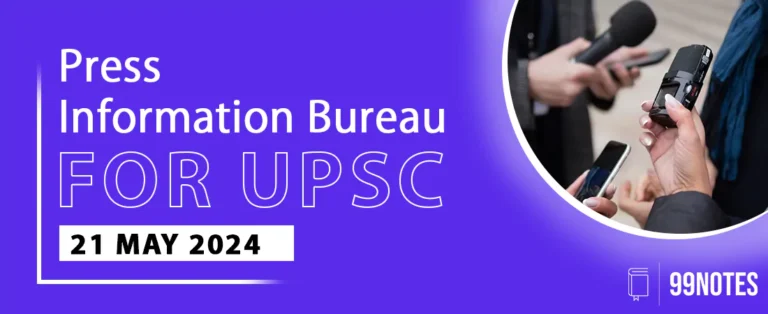7 June 2024 : Daily Current Affairs
1. ‘India must spend up to $385 bn for RE goal’
- 1. ‘India must spend up to $385 bn for RE goal’
- 2. Russia defends OPEC+ oil pact, says may tweak if needed
- 3. India’s Lok Sabha Sees 74 Women MPs Elected, Reflecting Slow but Steady Increase in Gender Representation
- 4. Supreme Court Orders Release of Surplus Water to Resolve Delhi’s Crisis Amid Heatwave
- 5. Sharif’s China Visit Aims to Revitalize Stalled CPEC Amid Security and Economic Challenges
- Prelims Facts
- 1. 65.79% turnout in 2024 Lok Sabha election, says EC
- 2. NHRC seeks report on Nata Pratha practice
- 3. Regulator SEBI expands promoter definition for IPO-bound companies
- 4. SpaceX’s Starship Achieves Breakthrough with Successful Hypersonic Return and Landing
| Topic: GS3 – Infrastructure – Energy |
| Context |
|
Analysis of the news:
- India aims for 500 GW of renewable energy capacity by 2030, requiring a $385 billion investment, says Moody’s Ratings.
- Despite this target, coal will continue to play a significant role in electricity generation over the next decade.
- India missed its previous target of 175 GW by 2022.
- Moody’s estimates an annual addition of about 44 GW will be necessary to achieve the 500 GW goal.
- This will necessitate spending $190-215 billion on capacity and $150-170 billion on transmission and distribution over six to seven years.
- India’s power capacity mix in fiscal 2023-24 comprised about 43% renewable energy, fueled by strong policy support and attracting private investments.
|
PYQ: Q.1 Examine the potential of wind energy in India and explain the reasons for their limited spaSal spread. (UPSC CSE (M) GS-1 2022) Q.2 India has immense potential of solar energy though there are regional variations in its development. Elaborate. (250 words/15m) (UPSC CSE (M) GS-1 2020) |
| Practice Question: What are the investment requirements and challenges associated with India’s goal of achieving 500 GW of renewable energy capacity by 2030, alongside the continued significance of coal in electricity generation?” (250 Words /15 marks) |
(Source – The Hindu, International Edition – Page No. – 10)
2. Russia defends OPEC+ oil pact, says may tweak if needed
| Topic: GS2 – International Relations |
| Context |
|
Analysis of the news:
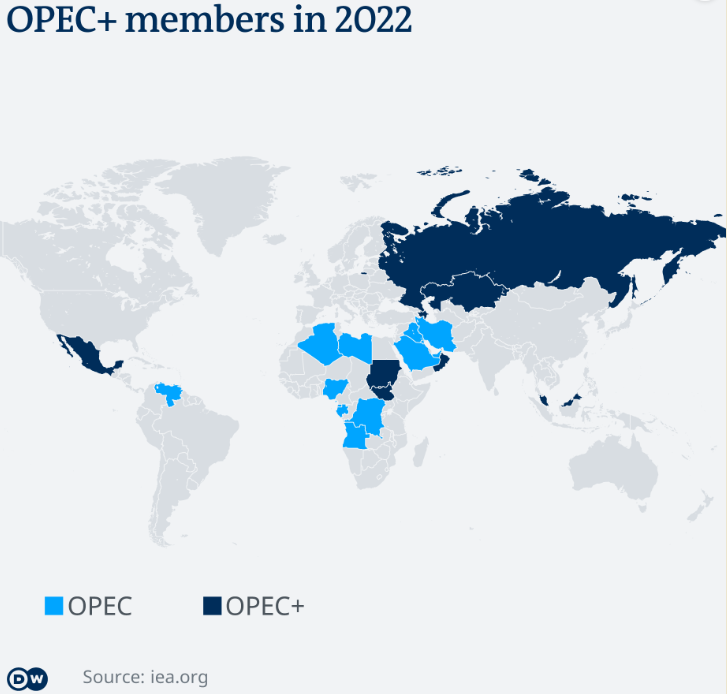
- OPEC+ is extending most of its oil output cuts into 2025, aimed at balancing oil supply and demand and providing market stability.
- Russian Deputy Prime Minister Alexander Novak emphasized the group’s readiness to adjust the agreement if necessary to support the market.
- Following the extension announcement, Brent crude oil prices fell below $80 per barrel, a key price level for many OPEC+ members to balance their budgets.
- The Organization of the Petroleum Exporting Countries (OPEC) and its allies, including Russia, have been implementing deep output cuts since late 2022.
- Currently, OPEC+ members are cutting production by 5.86 million barrels per day (bpd), approximately 5.7% of global demand.
- In addition to these cuts, some members, including Russia, agreed to phase out voluntary cuts of 2.2 million bpd from October 2023 to September 2025.
- Alexander Novak stated that Russia is working on establishing its oil production capacity by autumn 2025.
- OPEC+ aims to agree on oil production capacity for member countries by the end of 2024, addressing a historically contentious issue since each nation’s output target is based on its notional capacity.
| What is OPEC+: |
|
| Practice Question: Analyse the role of OPEC+ in stabilising global oil markets and the implications of its recent decision to extend output cuts into 2025. Discuss how such decisions impact global economies and energy policies. (150 Words /10 marks) |
(Source – The Hindu, International Edition – Page No. – 11)
3. India’s Lok Sabha Sees 74 Women MPs Elected, Reflecting Slow but Steady Increase in Gender Representation
| Topic: GS1 – Indian Society – Salient features of Indian Society |
| Context: |
|
Analysis of News:
Slow Change:
- Over the decades, the gender composition of the Lok Sabha has displayed a gradual but inconsistent trend toward greater women’s representation. In the first Lok Sabha of 1952, women constituted a mere 4.41% of the body.
- This percentage rose to over 6% in the 1962 elections but subsequently fell below 4% by 1971, despite the tenure of Indira Gandhi, India’s first and only female Prime Minister at that time.
- Since the 1970s, there has been a slow but steady increase in the proportion of women MPs, with occasional fluctuations. The representation of women crossed the 10% threshold in 2009 and reached its peak at 14.36% in 2019.
- However, India still trails behind several other countries, such as South Africa (46%), the UK (35%), and the US (29%), in terms of women’s representation in parliament.
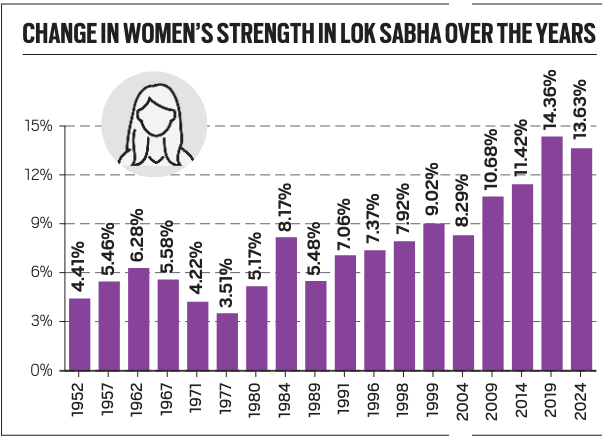
Party-wise Share:

- The 74 women MPs elected in 2024 come from 14 different political parties. The Bharatiya Janata Party (BJP) leads with 31 women MPs, followed by the Congress Party with 13 and the Trinamool Congress (TMC) with 11.
- Other parties include the Samajwadi Party (SP) with five, the Dravida Munnetra Kazhagam (DMK) with three, and the Chirag Paswan-led Lok Janshakti Party (Ram Vilas) and Janata Dal (United) each with two women MPs.
- Seven parties have one woman MP each. Among the parties with double-digit women MPs, the TMC has the highest proportion of women (37.93%), followed by the Congress (13.13%) and the BJP (12.92%).
New Faces, Younger Representatives:
- Of the 74 women MPs elected in 2024, 43 are first-time MPs, including Misa Bharti of the Rashtriya Janata Dal (RJD), who is serving her first term in the Lok Sabha.
- This influx of newcomers (59%) is slightly higher than the overall percentage of new MPs in the House (52%). The average experience of women MPs is 0.76 terms, indicating that many are new to the parliamentary system.
- Furthermore, women MPs have an average age of 50 years, younger than the overall average age of 56 years in the Lok Sabha. Educationally, 78% of the women MPs have completed their undergraduate studies, comparable to their male counterparts.
Candidates’ Composition:
- In the 2024 Lok Sabha elections, women comprised about 10% of the total 8,360 candidates. This figure marks a significant increase from 3% in 1957 and is the first time the proportion of women candidates has reached double digits.
- The BJP fielded 16% women candidates, and the Congress fielded 13%, both of which are above the overall average.
- This increase in the number of female candidates reflects a growing recognition of the need for greater gender parity in political representation, although there is still considerable room for improvement.
| Challenges in Women’s Representation in National and State Legislatures |
|
| Practice Question: Discuss the trends and challenges in women’s representation in the Lok Sabha from 1952 to 2024. How have political parties contributed to these trends? (250 words/15 m) |
4. Supreme Court Orders Release of Surplus Water to Resolve Delhi’s Crisis Amid Heatwave
| Topic: GS2 – Polity |
| Context: |
|
Analysis of News:
Delhi’s Water Sources:
- Delhi sources its water primarily from the Yamuna, Ravi-Beas, and Ganga rivers. The city receives 470 cusecs of water from the Ganga via the Upper Ganga Canal in Uttar Pradesh.
- From Haryana, Delhi is supplied with water through two main channels: the Carrier Lined Channel (CLC) and the Delhi Sub Branch (DSB), which collectively provide around 565 million gallons per day (MGD) from the Yamuna and Ravi-Beas rivers.
- Additionally, Delhi Jal Board (DJB) supplements this with groundwater, extracting about 135 MGD from tubewells and ranney wells.
Trigger for Delhi’s Water Shortage:
- The water treatment plant (WTP) in North Delhi’s Wazirabad was operating below capacity from May 12 to 14, and again from May 18 to June 1, coinciding with record high temperatures and a surge in water demand.
- The Wazirabad WTP, which serves significant parts of Delhi, depends heavily on water from the CLC and DSB.
- While this supply was maintained, the plant also draws water directly from the Yamuna at the Wazirabad reservoir, where supply issues primarily arose.
Impact of Rainfall Deficit:
- From May 1 to 24, Himachal Pradesh, Punjab, Haryana, and Delhi experienced large rainfall deficits, leading to lower water levels in the Yamuna.
- The water level at the Wazirabad reservoir fell below the normal 674.5 feet, reaching 670.3 feet on May 31. This drop hindered DJB’s ability to draw sufficient water for treatment.
- Although levels have slightly risen to 671 feet, this is not the first time such a situation has occurred, with even lower levels recorded in previous years, such as 667.7 feet in June 2022.
Water Allocation and Losses:
- Delhi’s water allotment from the Yamuna is governed by a 1994 agreement among Haryana, Uttar Pradesh, Rajasthan, Himachal Pradesh, and Delhi, specifying a provision of 0.076 billion cubic meters (BCM) from March to June and an annual allocation of 0.724 BCM, approximately 435 MGD.
- This agreement, managed by the Upper Yamuna River Board, is set for revision in 2025. Water levels are also affected by transit losses due to seepage and evaporation.
- For instance, a significant portion of the 352 cusecs released from Haryana’s Hathnikund barrage in summer is lost in transit.
| Historical Context and Supreme Court Intervention |
|
| PYQ: Constitutional mechanisms to resolve the inter-state water disputes have failed to address and solve the problems. Is the failure due to structural or process inadequacy or both? Discuss. (200 words/10m) (UPSC CSE (M) GS-2 2013) |
| Practice Question: Analyze the role of inter-state water agreements and judicial interventions in managing Delhi’s water supply. Discuss the factors that led to the recent water crisis in Delhi and evaluate the effectiveness of the measures taken to address it. (250 words/15 m) |
(Source: Indian Express; Section: Explained; Page: 15)
5. Sharif’s China Visit Aims to Revitalize Stalled CPEC Amid Security and Economic Challenges
| Topic: GS2 – International Relations |
| Context: |
|
Analysis of News:
CPEC: A Strategic Initiative:
- CPEC is designed to develop power plants, road and rail networks, and the deep-sea port of Gwadar in Pakistan.
- For China, CPEC provides a direct route to the Indian Ocean via highways passing through Pakistan-Occupied Kashmir and down the length of Pakistan.
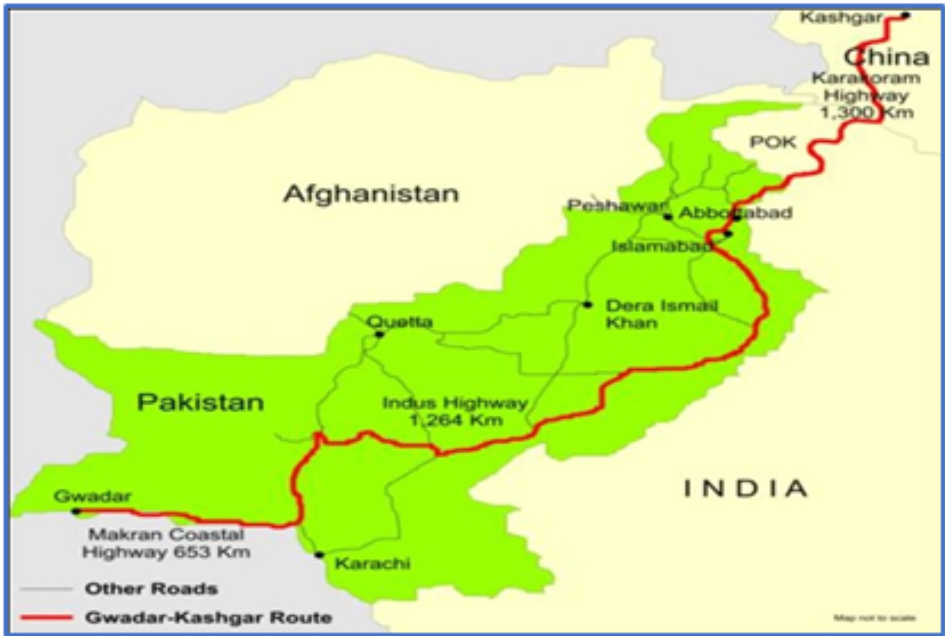
Progress and Challenges in CPEC:
- The first phase of CPEC focused on infrastructure, energy, and port development. As of now, only 14 out of 21 proposed power projects have been completed, and just six of 24 proposed transport projects have been finished.
- Special Economic Zones (SEZs) have seen limited progress, with only four out of nine seeing any development.
- Gwadar, a critical component of CPEC, remains underdeveloped, with most projects far from completion.
Hindrances to CPEC Progress:
- CPEC’s progress has been stalled by various factors, including Chinese concerns about corruption, bureaucratic hurdles, political instability in Pakistan, and a poor security situation, particularly in Balochistan.
- The region has seen violence against Chinese nationals, complicating project execution.
Security and Local Impact Issues:
- Balochistan’s restive situation, where Gwadar is located, has led to significant violence, with several Chinese workers killed in attacks.
- Local populations in Balochistan have seen little economic benefit from CPEC-related projects, leading to dissatisfaction and unrest.
Chinese Concerns and Structural Issues:
- Chinese investors have expressed frustration over Pakistan’s security issues and bureaucratic inefficiencies, which hinder business operations.
- Sharif has promised structural changes to combat corruption and improve security for Chinese workers, but challenges remain.
Economic Implications and Job Creation:
- While CPEC was expected to generate millions of jobs, it has so far created less than 250,000 positions.
- The limited involvement of local companies and the import of Chinese labor have reduced potential economic benefits for Pakistanis.
Debt Concerns and Economic Strain:
- China holds a significant portion of Pakistan’s external debt, creating concerns about Pakistan’s economic sovereignty and sustainability of debt obligations.
- The International Monetary Fund (IMF) has highlighted these issues, complicating Pakistan’s efforts to secure further financial support.
Conclusion:
- Sharif’s visit to China is crucial for addressing both the stalled progress of CPEC and the broader economic challenges facing Pakistan.
- However, the effectiveness of these efforts will depend on overcoming deep-seated issues of security, corruption, and political instability that have hampered CPEC’s progress thus far.
| India & CPEC |
|
| PYQ: The China-Pakistan Economic Corridor (CPEC) is viewed as a cardinal subset of China’s larger ‘One Belt One Road’ initiative. Give a brief description of CPEC and enumerate the reasons why India has distanced itself from the same. (150 words/10m) (UPSC CSE (M) GS-3 2018) |
| Practice Question: How does the China-Pakistan Economic Corridor (CPEC) impact India’s geopolitical and economic interests, and what strategies could India adopt to mitigate any potential challenges posed by CPEC? (250 words/15 m) |
(Source: Indian Express; Section: Explained; Page: 15)
Prelims Facts
1. 65.79% turnout in 2024 Lok Sabha election, says EC
| Context |
|
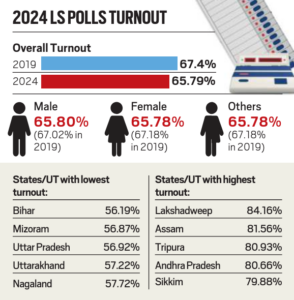 Analysis of the news:
Analysis of the news:
- The recently concluded 2024 Lok Sabha election had a turnout of 65.79%, slightly lower than 2019’s 67.4%.
- Chief Election Commissioner Rajiv Kumar stated that approximately 64.2 crore voters participated.
- Lakshadweep recorded the highest turnout at 84%, followed by Assam at 81%, while Bihar had the lowest at 56.19%.
- Uttar Pradesh and Mizoram also had low turnouts, with 56.92% and 56.87% respectively.
- The final figures may change pending inclusion of postal ballots.
- The overall voter turnout for the seventh phase was 63.88%.
- The Election Commission submitted the list of elected MPs to President Droupadi Murmu as per the Representation of People’s Act.
- Narendra Modi, after the BJP-led NDA’s majority win, is set to take oath for a third consecutive term on June 9.
(Source – The Hindu, International Edition – Page No. – 7)
2. NHRC seeks report on Nata Pratha practice
| Context |
|
What is Nata Pratha practice?
- Nata Pratha is a harmful traditional practice prevalent in certain communities in states like Rajasthan, Madhya Pradesh, Uttar Pradesh, and Gujarat.
- It involves the selling of girls, either on stamp paper or through informal means, under the pretext of illegal or child marriage.
- Often, these transactions are orchestrated by the girls’ own families.
- The practice results in severe violations of human rights and contributes to the perpetuation of gender inequality and exploitation.
- Girls subjected to Nata Pratha face physical, emotional, and psychological trauma, as they are essentially treated as commodities.
- The National Human Rights Commission (NHRC) has deemed the practice immoral and called for its immediate eradication and abolition.
- It has directed concerned states to submit reports on measures taken or proposed to address Nata Pratha within eight weeks.
- The NHRC recommends prosecuting individuals involved in forcing women into Nata Pratha under laws related to human trafficking to combat this egregious violation of human dignity.
(Source – The Hindu, International Edition – Page No. – 7)
3. Regulator SEBI expands promoter definition for IPO-bound companies
| Context |
| The stock exchanges have broadened the definition of promoters for companies going public, now including founders collectively holding 10% or more and their immediate relatives if they are on the board or key managerial personnel. |
Old Definition:
- Under current SEBI regulations, a promoter is someone who controls the company’s affairs, appoints the majority of directors, or is named as such in an offer document.
- Founders holding 25% were considered promoters due to their negative control and power to block special resolutions.
New Definition:
- SEBI now insists that founders holding 10% or more classify themselves as promoters for IPO-bound companies.
- The new guidelines extend to founders collectively holding 10% if they are key managerial personnel (KMP) or directors.
- Immediate relatives of promoters will also be deemed promoters if they hold 10% or more in the company, directly or indirectly.
- This expansion of the definition encompasses relatives who are not involved in management or board roles but hold significant shares, significantly broadening the promoter group’s scope.
4. SpaceX’s Starship Achieves Breakthrough with Successful Hypersonic Return and Landing
| Context: |
|
Analysis of News:
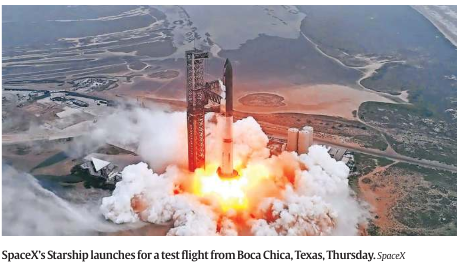
Test-to-Failure Development Approach:
- The controlled plunge into the Indian Ocean, just 65 minutes after launching from Texas, represents a critical advance in SpaceX’s test-to-failure rocket development strategy.
- This multibillion-dollar effort, spearheaded by Elon Musk’s space company, aims to develop a reusable satellite launcher and moon lander. The breakthrough achieved in this mission underscores the company’s commitment to iterative testing and improvement.
What is the Starship Project?
- SpaceX’s Starship spacecraft and Super Heavy rocket – collectively referred to as Starship – represent a fully reusable transportation system designed to carry both crew and cargo to Earth orbit, the Moon, Mars and beyond.
- Starship will be able to carry up to 150 metric tonnes fully reusable and 250 metric tonnes expendable.
- Starship Super Heavy is powered by an array of Raptor engines, which are fueled by liquid methane (CH4) and liquid oxygen (LOX).
- A total of 33 Raptor engines power the first-stage booster.
- It leverages tanker vehicles (essentially the Starship spacecraft minus the windows) to refill the Starship spacecraft in low-Earth orbit.
- Development and manufacturing of Starship takes place at Starbase, one of the world’s first commercial spaceports designed for orbital missions.



